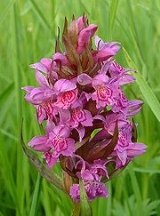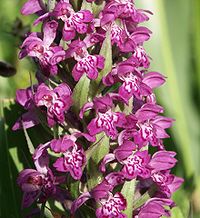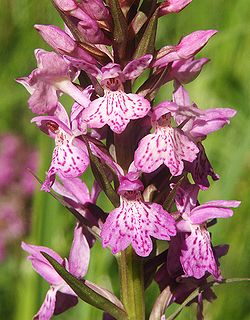
Western marsh orchid
Encyclopedia
The western marsh orchid (Dactylorhiza majalis; also broad-leaved marsh orchid, fan orchid, common marsh orchid) is a terrestrial Europe
an orchid
. Its flowering period begins at lower elevations as early as the beginning of May and ends in higher elevations at the end of July. The lowest blossoms usually open even before the stem has reached its full height.
The western marsh orchid grows mainly in nitrogen
-poor marsh
areas that consist of several plant communities
. More rarely, it is found in fen
s.
 The western marsh orchid is usually 15 to 40 cm (6 to 16 in.) tall, though some specimens may reach 60 cm (2 ft). Three to eight dark spotted leaves
The western marsh orchid is usually 15 to 40 cm (6 to 16 in.) tall, though some specimens may reach 60 cm (2 ft). Three to eight dark spotted leaves
are distributed on the stem, which is hollow. The lower leaves are ovate to lanceolate and 6 to 18 cm (2⅜ to 7 in.) long and 1.5 to 3.5 cm (⅝ to 1⅜ in.) wide. The upper leaves are increasingly smaller and more lanceolate. The bract
s are about as long as the blossom and cover it before it blooms. The densely flowered inflorescence
, which is 4 to 15 cm (1½ to 6 in.) long, is at first conical, but distinctly cylindrical when in full blossom. The seven to forty blossoms are colored purplish red, rarely light pink or white. The lateral tepal
s of the external circle of the perianth
stand obliquely or vertically upright. They are 7 to 12 mm (¼ to ½ in.) long and 2.5 to 5 mm (⅛ to 3⁄16 in.) wide. The middle tepal is smaller and forms a "helmet" together with the two lateral tepals of the internal circle. These are 6 to 11 mm (¼ to 7⁄16 in.) long. The trilobate lip is 5 to 10 mm (3⁄16 to ⅜ in.) long and 7 to 14 mm (¼ to 9⁄16 in.) wide. The shape and pattern of the lips are variable. In the lighter central area of the lip the markings are made up of lines, streaks, or dots. The spur is bent slightly downwards and is not quite as long as the ovary
. The tuber
has a palmate division and an irregular shape.
The western marsh orchid has a karyotype
of two sets of forty chromosome
s. The seed
of this orchid contains no endosperm
for the embryo
. Therefore, germination
can take place only by means of infection with a root fungus (mycorrhiza
).

to the Baltic
and to the Don, possible even to the Volga
. The western marsh orchid is not found south of the Alps
and is rare in southern Scandinavia
.
In Germany
the western marsh orchid is widespread but with several gaps. In many places, especially from western to northern Germany, it is extinct.
In Switzerland
the western marsh orchid is also quite widespread. A significant gap is found south of the Aar between Aarau
and Lake Neuchâtel
.
As with many marsh plants, the numbers of this species have been dwindling for quite some time. The main causes are the entry of nitrogen via fertilizer, drying out of the habitat, and intensive conversion to pasture. The western marsh orchid does not react so sensitively to changes in its habitat as for example the early marsh orchid. It is usually the last of the native orchids to disappear. This tolerance makes it a still relatively common species.


described the western marsh orchid as Orchis majalis. The name became the basionym
after Peter Francis Hunt and Victor Samuel Summerhayes transferred the species to the genus Dactylorhiza in 1965. Sometimes the name Dactylorhiza fistulosa is used, but since this description is not valid, the name cannot be used despite its earlier publication in 1794 as Orchis fistulosa.
Synonyms:
This article incorporates text translated from the corresponding German and French Wikipedia articles as of 4 February 2006.
Europe
Europe is, by convention, one of the world's seven continents. Comprising the westernmost peninsula of Eurasia, Europe is generally 'divided' from Asia to its east by the watershed divides of the Ural and Caucasus Mountains, the Ural River, the Caspian and Black Seas, and the waterways connecting...
an orchid
Orchidaceae
The Orchidaceae, commonly referred to as the orchid family, is a morphologically diverse and widespread family of monocots in the order Asparagales. Along with the Asteraceae, it is one of the two largest families of flowering plants, with between 21,950 and 26,049 currently accepted species,...
. Its flowering period begins at lower elevations as early as the beginning of May and ends in higher elevations at the end of July. The lowest blossoms usually open even before the stem has reached its full height.
The western marsh orchid grows mainly in nitrogen
Nitrogen
Nitrogen is a chemical element that has the symbol N, atomic number of 7 and atomic mass 14.00674 u. Elemental nitrogen is a colorless, odorless, tasteless, and mostly inert diatomic gas at standard conditions, constituting 78.08% by volume of Earth's atmosphere...
-poor marsh
Marsh
In geography, a marsh, or morass, is a type of wetland that is subject to frequent or continuous flood. Typically the water is shallow and features grasses, rushes, reeds, typhas, sedges, other herbaceous plants, and moss....
areas that consist of several plant communities
Biocoenosis
A biocoenosis , coined by Karl Möbius in 1877, describes the interacting organisms living together in a habitat . This term is rarely used in English, as this concept has not been popularized in Anglophone countries...
. More rarely, it is found in fen
Fen
A fen is a type of wetland fed by mineral-rich surface water or groundwater. Fens are characterised by their water chemistry, which is neutral or alkaline, with relatively high dissolved mineral levels but few other plant nutrients...
s.
Anatomy

Leaf
A leaf is an organ of a vascular plant, as defined in botanical terms, and in particular in plant morphology. Foliage is a mass noun that refers to leaves as a feature of plants....
are distributed on the stem, which is hollow. The lower leaves are ovate to lanceolate and 6 to 18 cm (2⅜ to 7 in.) long and 1.5 to 3.5 cm (⅝ to 1⅜ in.) wide. The upper leaves are increasingly smaller and more lanceolate. The bract
Bract
In botany, a bract is a modified or specialized leaf, especially one associated with a reproductive structure such as a flower, inflorescence axis, or cone scale. Bracts are often different from foliage leaves. They may be smaller, larger, or of a different color, shape, or texture...
s are about as long as the blossom and cover it before it blooms. The densely flowered inflorescence
Inflorescence
An inflorescence is a group or cluster of flowers arranged on a stem that is composed of a main branch or a complicated arrangement of branches. Strictly, it is the part of the shoot of seed plants where flowers are formed and which is accordingly modified...
, which is 4 to 15 cm (1½ to 6 in.) long, is at first conical, but distinctly cylindrical when in full blossom. The seven to forty blossoms are colored purplish red, rarely light pink or white. The lateral tepal
Tepal
Tepals are elements of the perianth, or outer part of a flower, which include the petals or sepals. The term tepal is more often applied specifically when all segments of the perianth are of similar shape and color, or undifferentiated, which is called perigone...
s of the external circle of the perianth
Perianth
The term perianth has two similar but separate meanings in botany:* In flowering plants, the perianth are the outer, sterile whorls of a flower...
stand obliquely or vertically upright. They are 7 to 12 mm (¼ to ½ in.) long and 2.5 to 5 mm (⅛ to 3⁄16 in.) wide. The middle tepal is smaller and forms a "helmet" together with the two lateral tepals of the internal circle. These are 6 to 11 mm (¼ to 7⁄16 in.) long. The trilobate lip is 5 to 10 mm (3⁄16 to ⅜ in.) long and 7 to 14 mm (¼ to 9⁄16 in.) wide. The shape and pattern of the lips are variable. In the lighter central area of the lip the markings are made up of lines, streaks, or dots. The spur is bent slightly downwards and is not quite as long as the ovary
Ovary (plants)
In the flowering plants, an ovary is a part of the female reproductive organ of the flower or gynoecium. Specifically, it is the part of the pistil which holds the ovule and is located above or below or at the point of connection with the base of the petals and sepals...
. The tuber
Tuber
Tubers are various types of modified plant structures that are enlarged to store nutrients. They are used by plants to survive the winter or dry months and provide energy and nutrients for regrowth during the next growing season and they are a means of asexual reproduction...
has a palmate division and an irregular shape.
The western marsh orchid has a karyotype
Karyotype
A karyotype is the number and appearance of chromosomes in the nucleus of an eukaryotic cell. The term is also used for the complete set of chromosomes in a species, or an individual organism.p28...
of two sets of forty chromosome
Chromosome
A chromosome is an organized structure of DNA and protein found in cells. It is a single piece of coiled DNA containing many genes, regulatory elements and other nucleotide sequences. Chromosomes also contain DNA-bound proteins, which serve to package the DNA and control its functions.Chromosomes...
s. The seed
Seed
A seed is a small embryonic plant enclosed in a covering called the seed coat, usually with some stored food. It is the product of the ripened ovule of gymnosperm and angiosperm plants which occurs after fertilization and some growth within the mother plant...
of this orchid contains no endosperm
Endosperm
Endosperm is the tissue produced inside the seeds of most flowering plants around the time of fertilization. It surrounds the embryo and provides nutrition in the form of starch, though it can also contain oils and protein. This makes endosperm an important source of nutrition in human diet...
for the embryo
Embryo
An embryo is a multicellular diploid eukaryote in its earliest stage of development, from the time of first cell division until birth, hatching, or germination...
. Therefore, germination
Germination
Germination is the process in which a plant or fungus emerges from a seed or spore, respectively, and begins growth. The most common example of germination is the sprouting of a seedling from a seed of an angiosperm or gymnosperm. However the growth of a sporeling from a spore, for example the...
can take place only by means of infection with a root fungus (mycorrhiza
Mycorrhiza
A mycorrhiza is a symbiotic association between a fungus and the roots of a vascular plant....
).

Range
The range extends in Europe from the PyreneesPyrenees
The Pyrenees is a range of mountains in southwest Europe that forms a natural border between France and Spain...
to the Baltic
Baltic Sea
The Baltic Sea is a brackish mediterranean sea located in Northern Europe, from 53°N to 66°N latitude and from 20°E to 26°E longitude. It is bounded by the Scandinavian Peninsula, the mainland of Europe, and the Danish islands. It drains into the Kattegat by way of the Øresund, the Great Belt and...
and to the Don, possible even to the Volga
Volga River
The Volga is the largest river in Europe in terms of length, discharge, and watershed. It flows through central Russia, and is widely viewed as the national river of Russia. Out of the twenty largest cities of Russia, eleven, including the capital Moscow, are situated in the Volga's drainage...
. The western marsh orchid is not found south of the Alps
Alps
The Alps is one of the great mountain range systems of Europe, stretching from Austria and Slovenia in the east through Italy, Switzerland, Liechtenstein and Germany to France in the west....
and is rare in southern Scandinavia
Scandinavia
Scandinavia is a cultural, historical and ethno-linguistic region in northern Europe that includes the three kingdoms of Denmark, Norway and Sweden, characterized by their common ethno-cultural heritage and language. Modern Norway and Sweden proper are situated on the Scandinavian Peninsula,...
.
In Germany
Germany
Germany , officially the Federal Republic of Germany , is a federal parliamentary republic in Europe. The country consists of 16 states while the capital and largest city is Berlin. Germany covers an area of 357,021 km2 and has a largely temperate seasonal climate...
the western marsh orchid is widespread but with several gaps. In many places, especially from western to northern Germany, it is extinct.
In Switzerland
Switzerland
Switzerland name of one of the Swiss cantons. ; ; ; or ), in its full name the Swiss Confederation , is a federal republic consisting of 26 cantons, with Bern as the seat of the federal authorities. The country is situated in Western Europe,Or Central Europe depending on the definition....
the western marsh orchid is also quite widespread. A significant gap is found south of the Aar between Aarau
Aarau
Aarau is the capital of the northern Swiss canton of Aargau. The city is also the capital of the district of Aarau. It is German-speaking and predominantly Protestant. Aarau is situated on the Swiss plateau, in the valley of the Aar, on the river's right bank, and at the southern foot of the Jura...
and Lake Neuchâtel
Lake Neuchâtel
Lake Neuchâtel is a lake in Romandy, Switzerland . The lake lies mainly in the canton of Neuchâtel, but is also shared by the cantons of Vaud, of Fribourg, and of Bern....
.
Conservation and endangerment
Although the western marsh orchid is commonly found in some regions, it is nevertheless protected as an orchid.As with many marsh plants, the numbers of this species have been dwindling for quite some time. The main causes are the entry of nitrogen via fertilizer, drying out of the habitat, and intensive conversion to pasture. The western marsh orchid does not react so sensitively to changes in its habitat as for example the early marsh orchid. It is usually the last of the native orchids to disappear. This tolerance makes it a still relatively common species.
Varieties and hybrids


- Variety:
- Dactylorhiza majalis var. pumila (Synonym: Dactylorhiza majalis var. alpestris), an Alpine variety.
- Hybrids:
- The western marsh orchid hybridizes quite commonly with other species of its genus.
- Dactylorhiza × aschersoniana (incarnata × majalis)
- Dactylorhiza × braunii (fuchsiiCommon spotted orchidThe Common Spotted-orchid is acommonly occurring species of European orchid. It is widely variable in colour and height, ranging from 15 to 60 cm in height. The flower colour can vary from white to pale purple with purple spots. The lip has three lobes...
× majalis) - Dactylorhiza × dufftiana (majalis × traunsteineri)
- Dactylorhiza × godferyana (majalis × praetermissa)
- Dactylorhiza × kuehnensis (majalis × ruthei
- Dactylorhiza × townsendiana (maculata × majalis)
- Dactylorhiza × rupertii (majalis × sambucina)
- More rarely hybrids with other genera (intergeneric hyrids) occur.
- ×Dactyloglossum drucei (Coeloglossum viride ×Dactylorhiza majalis)
- ×Dactylodenia lebrunii (Dactylorhiza majalis × Gymnadenia conopseaFragrant orchidFragrant Orchid is an herbaceous plant belonging to the family Orchidaceae.-Etymology:The name of the genus Gymnodenia is formed from Greek words "gymnos" meaning "nude" and "adèn" meaning "gland" and refers to the characteristics of the organs for secreting nectar...
)
Classification
In 1828 Ludwig ReichenbachLudwig Reichenbach
Heinrich Gottlieb Ludwig Reichenbach was a German botanist and ornithologist.He was the son of Johann Friedrich Jakob Reichenbach, the author in 1818 of the first Greek-German dictionary. He was the father of Heinrich Gustav Reichenbach, equally a botanist and an eminent orchid...
described the western marsh orchid as Orchis majalis. The name became the basionym
Basionym
Basionym is a term used in botany, regulated by the International Code of Botanical Nomenclature...
after Peter Francis Hunt and Victor Samuel Summerhayes transferred the species to the genus Dactylorhiza in 1965. Sometimes the name Dactylorhiza fistulosa is used, but since this description is not valid, the name cannot be used despite its earlier publication in 1794 as Orchis fistulosa.
Synonyms:
- Orchis majalis Rchb. 1828 (basionym)
- Dactylorchis majalis (Rchb.) Verm. 1947
- Dactylorhiza comosa ssp. majalis (Rchb.) P.D. Sell & G.Murrell 1996
- Orchis fistulosa MoenchConrad MoenchConrad Moench was a German botanist, sometimes written Konrad Mönch, was Professor of Botany at the Marburg University from 1786 until his death....
1794 nom. illeg. - Dactylorhiza fistulosa (Moench) H. Baumann & Künkele 1983 nom. illeg.
This article incorporates text translated from the corresponding German and French Wikipedia articles as of 4 February 2006.

